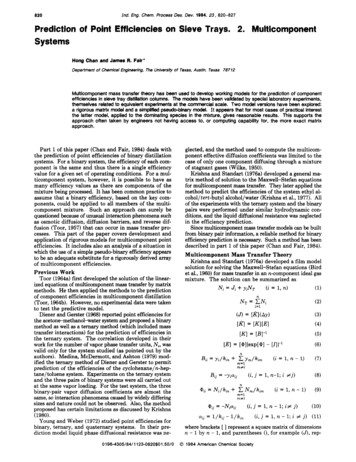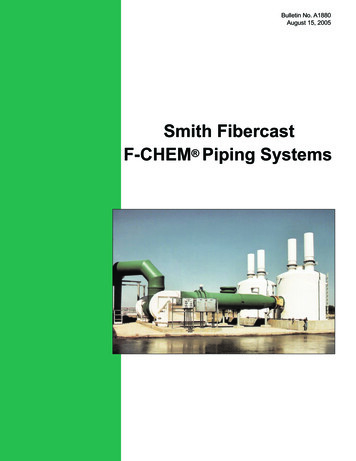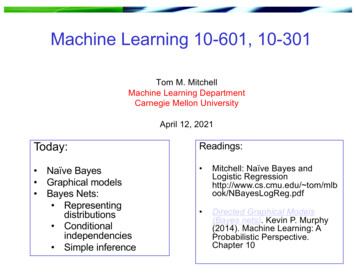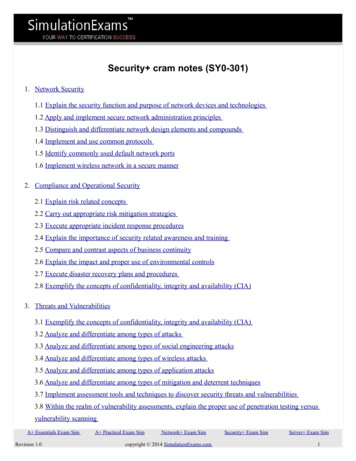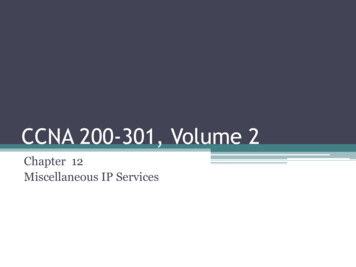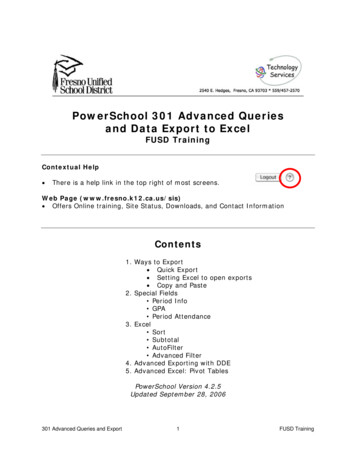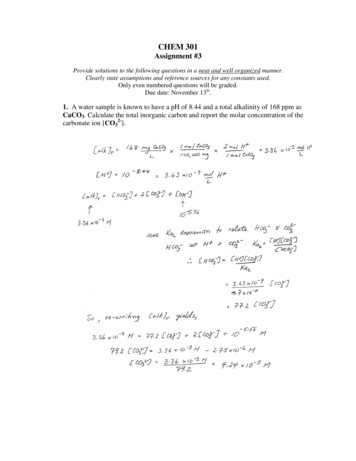
Transcription
CHEM 301Assignment #3Provide solutions to the following questions in a neat and well organized manner.Clearly state assumptions and reference sources for any constants used.Only even numbered questions will be graded.Due date: November 13th.1. A water sample is known to have a pH of 8.44 and a total alkalinity of 168 ppm asCaCO3. Calculate the total inorganic carbon and report the molar concentration of thecarbonate ion [CO32-].
2. You find a value for the KH of methyl-tert-butyl ether (MTBE) reported as 5.8 x10-4 atm m3 mol-1. Convert this to units of M Pa-1.Strategy: We note that the units given for KH are pressure (atm) times inverse concentration(m3/mol). Therefore the KH given is for the equilibrium of aqueous MTBE into the gasphase.MTBE (aq) MTBE (g)We want to express the Henry’s law constant for the inverse reaction and express it in unitsused in the textbook (i.e., M Pa-1).Solution:atm m3 101,300 Pa 103 LPa L5.8 x 10xx 3 58,750molatmmmol-4inverting this yields 1.70 x 10-5 M Pa-1
3. Calculate the pH of fog equilibrated with an unlimited supply of air containing0.25 ppmv SO2(g). Now extend this calculation by determining the additional [H ]that will be contributed by the equilibrium concentration of atmospheric CO2(g).Strategy: The concentration of aqueous SO2 in equilibrium with an inexhaustible supply ofatmospheric SO2(g) will be given by the partial pressure of sulfur dioxide and the value of thecorresponding Henry’s law constant. To calculate the pH of the solution, we will need thevalue of the acidic dissociation constant for sulfurous acid. (see textbook pgs 241-242; Chap11 Q6)Solution:We will need to consider both the dissolution of SO2(g) into water (KH) and the subsequentdissociation to produce protons (Ka1 and Ka2). These equilibria are summarized below.SO2(g) SO2(aq)SO2(aq) H2O H HSO3- H SO32-KH 1.8 x 10-5 M Pa-1 (text, Table 11.1) HSO3- Ka1 1.72 x 10-2 (text, App. B1)Ka2 6.43 x 10-8 (text, App. B1)Assuming a total pressure of one atmosphere, the PSO2 SO2 x PT 0.25 x 10-6 atm.Converting the given KH into atmospheres yields;1.8 x 10-5 M Pa-1 x 101,300 Pa atm-1 1.82 M atm-1Thus, [SO2(aq)] KH x PSO2 (1.82 M atm-1) (0.25 x 10-6 atm) 4.55 x 10-7 MUsing the Ka1 expression and assuming no further dissociation of HSO3- (i.e.,ignoring Ka2), yields;x2,K a1 [ SO2 (aq)]where x [H ] [HSO3-] and we assume that the atmosphere provides aninexhaustible supply of SO2(aq) [H ]2 (1.72 x 10-2) (4.55 x 10-7)so[H ] 8.85 x 10-5 M pH 4.05Note 1: If the SO2(aq) is oxidized to SO3(aq), the pH will be even lower since the resultingsulfuric acid (H2SO4) is stronger than sulfurous acid (H2SO3). See further the Ka1 and Ka2values for H2SO4.Note 2: A much lower pH results from a smaller amount of SO2 than for CO2. This is theresult of two factors KH(SO2) is larger and Ka1(SO2) is larger.Note 3: If we consider the second dissociation using the Ka2 expression, we solve for anadditional [H ] (Ka2 x [HSO3-])1/2 1.7 x 10-7 M, which makes a relatively insignificantcontribution to the pH when added to the 8.85 x 10-5 M already present from the firstdissociation, [H ] 8.85 x 10-5 1.7 x 10-7 8.86 x 10-5 M).
4. Methane and carbon dioxide are produced under anaerobic conditions by thefermentation of organic matter, approximated by the following equation2 {CH2O} CH4 CO2As gas bubbles evolve at the sediment interface at a depth of 50 meters and remain incontact with water at the sediment surface long enough so that equilibrium is attained,calculate the aqueous molar concentration of methane in the interstitial sediment porewater. Assume a total pressure at this depth of 0.61 MPa and a temperature of 5oC.Strategy: The total pressure inside the gas bubble must be equal to the total pressure on theoutside of the gas bubble (or else it would either explode or collapse). Furthermore, the totalpressure inside that gas bubble is equal to the sum of the partial pressures of CH4 and CO2. Wecan then use the partial pressure of CH4 inside the gas bubble and the corresponding Henry’s lawconstant to calculate the concentration of aqueous CH4 at equilibrium in the pore water.Solution:The aqueous concentration of methane is given by the Henry’s Law expression;[CH4(aq)] KH x PCH4(g)Where KH is for methane at 5oC (278 K) and PCH4 is given by;PT 0.61 MPa PCO2 PCH4and PCO2 PCH4 0.305 MPa(Since this reaction is occurring under anaerobic conditions, these are the only gaseslikely to be presence at appreciable concentrations and they are produced with 1:1stoichiometry).In order to ‘solve’ this problem, we need or calculate KH for CH4 at 278K. Since theKH value for methane (textbook, Table 11.1) is reported at 25oC (298K), we will needto adjust to a lower temperature (recall; gases are more water soluble at lowertemperature, so we expect KH to be greater at 278K than at 298K).Recall, all equilibrium constants are temperature dependent and this dependence canbe expressed as a variation of the Clausius – Clapeyron equation.æ K ö -DH orxn æ 1 1 öln ç T 2 ç - R è T2 T1 øè KT1 øwhere T1 298K, T2 278K, KT1 1.4 x 10-8 M Pa-1, R 8.314 J mol-1 K-1, Horxn enthalpy change for the aqueous dissolution of methane at std state conditions andKT2 Henry’s law constant for methane at 278K.CH4(g) CH4(aq) Horxn [ Hof (CH4(aq)] – [ Hof (CH4(g)] (-89.04 kJ mol-1) – (-74.80 kJ mol-1) -14.24 kJ mol-1 (Water Chemistry, M. Benjamin, Appendix A1, p635)
Therefore,æK öln ç T 2 0.4135è KT1 øandKT2 KT1 e (0.4135) 2.12 x 10-8 M Pa-1From the Henry’s Law expression;[CH4(aq)] KH x PCH4Using the KH calculated above yields;[CH4(aq)] 2.12 x 10-8 M Pa-1 x 305,000 Pa 6.5 mM
5. A pollutant is dumped into a clean lake at a constant rate starting on July 1, 2000.When the pollutant’s concentration reaches 90% of its steady state value, the flow ofpollutant into the lake is stopped altogether. On what date will the concentration ofpollutant fall to 1% of its maximum concentration? Assume the rate constants of theincrease and decrease are both 0.35 year-1.
6. Derive an expression for the concentration of calcium as a function of [H ] and PCO2for a water sample in equilibrium with atmospheric CO2(g) and limestone (CaCO3).CaCO3(s) CO2(g) H2O Ca2 2 HCO3Using Excel, plot the following graphs;i) [Ca2 ] as a function of PCO2 (0 – 0.0001 atm) at a constant pH 7.00ii) [Ca2 ] as a function of pH (4 – 10) at a constant PCO2 4.0 x 10-4 atmStrategy: The solubility of CaCO3(s) will be given by the concentration of Ca2 in equilibriumwith solid calcium carbonate and an inexhaustible supply of atmospheric carbon dioxide. If wecan determine the value of the equilibrium constant for the above reaction and independentlydetermine the concentration of HCO3-, we can rearrange the expression and calculate the [Ca2 ].Alternatively, we can write the solubility product expression for CaCO3 and rearrange for [Ca2 ].Making the appropriate substitutions, we can derive an expression for [Ca2 ] in terms of a seriesof equilibrium constants and the [H ].Solution:The solubility of calcium carbonate and thus the concentration of Ca2 , will vary withchanges in the PCO2 and [H ]. To derive an expression for the [Ca2 ] as a function ofPCO2, we must first determine the [H ].Rearranging the Ksp expression for CaCO3, we can write;[Ca2 ] Ksp/[CO32-]Remembering that we wish to express the [Ca2 ] in terms of PCO2 and [H ], we lookfor an appropriate substitution for [CO32-].Rearranging the Ka2 expression gives;[CO32-] Ka2 [HCO3-]/[H ]and we can substitute for [HCO3-] using the Ka1 expression;[HCO3-] {Ka1[CO2(aq)]/[H ]}and we can substitute for [CO2(aq)] using the KH expression;[CO2(aq)] KH PCO2Making these substitutions into the expression for [Ca2 ] gives;K sp [H ]22 [Ca ] K a1K a 2K H PCO2From this expression we can see that the concentration of calcium depends not onlyon the PCO2, but also on the equilibrium concentration of [H ] – which we know willalso depend on the PCO2.
To derive an expression for the [H ] as a function of PCO2, we will need an additionalindependent relationship – the charge balance equation. Since all solutions areelectrically neutral, we can write that the sum total of positive charges is equal to thesum total of negative charges.Thus;2 [Ca2 ] [H ] [HCO3-] 2 [CO32-] [OH-]For most natural water in contact with solid CaCO3 (pH ranges 5-9), this simplifiesto;2 [Ca2 ] [HCO3-]since [Ca2 ] [H ]and[HCO3-] [CO32-] and [OH-]So from the charge balance, we can write; [Ca2 ] ½ [HCO3-]Using the Ka1 and KH expressions to substitute for the [HCO3-] in terms of [H ] andPCO2 (as before), yields;[Ca 2 ] K a1K H PCO22[ H ]Since we now have two expressions for the concentration of Ca2 (one derived fromthe Ksp expression and the other from the charge balance), we can set them equal toeach other and solve for [H ] as a function of only the PCO2.Thus;K sp[ H ]2K a1K a 2 K H PCO2 K a1K H PCO22[ H ]Rearranging and solving for [H ] yields;22K K K P[ H ] 3 a1 H a 2 CO22 K sp 2Thus, we have an expression to calculate the [H ] at any PCO2. We can use this andthen substitute both the [H ] and the PCO2 into the expression for [Ca2 ] above andcalculate the equilibrium concentration of calcium.
[H ] 32 22K a1K HK a2 PCO22K spand[Ca ] 2 K sp [H ]2K a1K a2 K H PCO2Using Excel, let’s ploti) [Ca2 ] as a function of PCO2 (0 – 0.0001 atm) at a constant pH 7.00Equilibrium [Ca2 ] as function of PCO2 atpH 78.00E 047.00E 04[Ca2 ] (mM)6.00E 045.00E 044.00E 043.00E 042.00E 041.00E 040.00E 000.0E 00 2.0E-05 4.0E-05 6.0E-05 8.0E-05 1.0E-04PCO2 (atm)
ii) [Ca2 ] as a function of pH (4 – 10) at a constant PCO2 4.0 x 10-4 atm[Ca2 ] (mM)Equilibrium [Ca2 ] as function of pH atPCO2 0.0004 atm2.00E 081.80E 081.60E 081.40E 081.20E 081.00E 088.00E 076.00E 074.00E 072.00E 070.00E 004.0E 006.0E 00pH8.0E 001.0E 01Note: Neither of these plots look like the one we saw in class for [Ca2 ] vs PCO2 (Figure11.2, textbook). This is because the solubility of CaCO3 depends on both [H ] and PCO2and the [H ] itself is dependent on PCO2. In other words, when the PCO2 increases, the[H ] also increases. How the [Ca2 ] varies with PCO2, will depend on which effect isgreater, in this case the [H ].Equilibrium [Ca2 ] as function of PCO21.801.601.40[Ca2 ] (mM)1.201.000.800.600.400.200.000.0E 002.0E-034.0E-036.0E-03PCO2 (atm)8.0E-031.0E-02
7. Using the pKa values below for the aluminum aquo complexes, plot a pHspeciation diagram for the Al3 - Al(OH)2 - Al(OH)2 - Al(OH)3 – Al(OH)4- systemover the pH range of 0 to 14. Use a spreadsheet program (such as Excel) for repetitivecalculations and to plot curves for fractional abundance of each species. What is thedistribution of aluminum species at pH 5?pKa1 5.00pKa2 5.10 pKa3 6.80 pKa4 5.80pH Speciation for Al aquo speciesfraction of species1.00Al(OH)4-Al3 0.80Al(OH)2 Series10.600.40Series2AlOH2 0.20Al(OH)30.000.02.04.06.08.0pH10.0 12.0 14.0
8. Consider dissolved organic matter to have a generic formula {CH2O}. For a waterbody containing 1.0 mg/L of DOC, calculate the mass in mg of dissolved oxygen inthe same volume of water required to oxidize it completely. Use this calculation toestablish a numerical relationship between COD (mg/L O2) and DOC (mg/L C). Willyour result change markedly using the generic formula for dissolved humic material(Fig 12.3, textbook)?
9. Given the equilbria below, calculate the fractional abundance of Pb2 at pH 7.Pb2 OH- PbOH K 2.0 x 106PbOH OH- Pb(OH)2K 4.0 x 104Strategy:We will need an expression for the fractional abundance of Pb2 as a function of pH. We canapproach this in several ways, but to will consistent with out previous discussions on pHspeciation, I will re-write these complex ion formations as ‘acid dissociations’.(see textbook pgs 276-278, Chap 13 Q2)Solution:a Pb2 [Pb 2 ][Pb 2 ] [PbOH ] [Pb(OH) 2 ]Converting given equilibria to acid dissociations by adding the auto-ionization of water yields;Pb2 OH- PbOH H2O H OHPb2 H2O PbOH H Kf1 2.0 x 106Kw 1.0 x 10-14Ka1 Kf1x Kw 2.0 x 10-8PbOH OH- Pb(OH)2Kf2 4.0 x 104 H2O H OHKw 1.0 x 10-14PbOH H2O Pb(OH)2 H Ka2 Kf2 x Kw 4.0 x 10-10Therefore, pKa1 7.7 and pKa2 9.4Given the magnitude of the pKa values, it is reasonable to assume that theconcentration of Pb(OH)2 will be negligible at pH 7, hence we can simplify thefractional abundance expression as;[Pb 2 ]a Pb2 @[Pb 2 ] [PbOH ]Rearranging the Ka1 expression for [PbOH ] (Ka1 [Pb2 ])/[H ] and substituting intothe fractional abundance expression yields;[Pb 2 ]a Pb2 @ [Pb 2 ] [PbOH ][Pb 2 ]1[H ] K a1[Pb 2 ] 1 K a1 [H ] K a12 [Pb ] [H ][H ]Hence at pH 7, the fractional abundance of Pb2 0.833
10. A woodwaste leachate sample has a Fe(II) concentration of 20 mg/L and adissolved organic matter concentration of 50 mg/L. Using a typical value for theconcentration of carboxylate ions of per gram of DOM given in the text and theconditional formation constant between Fe2 and fulvic acid of 5 x 103 at pH 5,calculate the fraction of iron (II) complexed to the dissolved organic matter at pH 5.How would you expect your answer to change if the actual pH of the leachate were 7rather than 5? Explain.
11. What fraction of NTA (H3T) is uncomplexed after H2T- has been brought toequilibrium with solid PbCO3 in an aqueous solution containing 1.25 mM HCO3- atpH 7.PbCO3(s) HT2- PbT- HCO3log Ksp (PbCO3) -13.13log Kf PbT- 11.34Strategy:We want to solve for the fraction of NTA uncomplexed, which can be represented as thefraction [HT2-]/([HT2-] [PbT-]). Let’s write out an equilibrium expression for thereaction given and and solve for [HT2-]/[PbT-]. If we can calculate the value of Keq fromthe information provided, we should be able to solve this one.Solution:a N
-14.24 kJ mol-1 (Water Chemistry, M. Benjamin, Appendix A1, p635) Therefore, ln K T2 K T1 æ è ç ö ø 0.4135 and K T2 K T1 e (0.4135) 2.1 2 x 10-8 M Pa-1 From the Henry’s Law expression; [CH 4 (aq)] K H x P CH4 Using the K H calculated above yields; [CH 4 (aq)] 2.1 2 x 10-8 M Pa-1 x 305,000 Pa 6.5 mM . 5. A pollutant is dumped into a clean lake at a constant rate starting .
